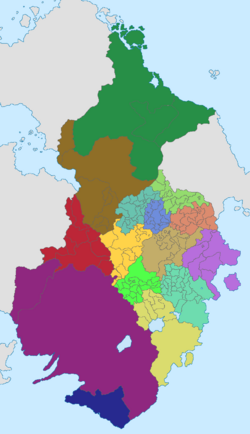Imperial Diet
This article is a work-in-progress because it is incomplete and pending further input from an author. Note: The contents of this article are not considered canonical and may be inaccurate. Please comment on this article's talk page to share your input, comments and questions. |

The Imperial Diet (Latin: Dieta Imperii/Comitium Imperiale) was the deliberative body of the Holy Levantine Empire. It was not initially a legislative body in the contemporary sense for most of its history; its members envisioned it more like a central forum where it was more important to negotiate than to decide. During the 1850s, attempted reforms of the Empire changed the mandate of the Diet into a more modern legislative role, albeit one with limited authority. The Diet is considered a predecessor of the modern Levantine Union Diet, which continues to meet in Corcra using many of the same rules of order as the late Diet.
Its members were the Imperial Estates, divided into three colleges, the senior most of which was the Collegial Electorate. The Diet as a permanent, regularized institution evolved from the court assembles of the early medieval period. From 1301 until the end of the empire in 1935, it was in permanent session at Corcra (though from the beginning of the Second Great War to its end it met in Urceopolis), making it the longest-serving deliberative body in history. Joining the Imperial Estates in 1859 were elected representatives from each of the 35 Imperial Circles.
The Imperial Estates originally had, according to feudal law, no authority above them besides the Emperor of the Levantines (or emperor-elect) himself. The holding of an Imperial Estate entitled one to a vote in the diet. Thus, an individual member might have multiple votes and votes in different colleges. In general, members did not attend the permanent diet at Corcra, but sent representatives instead. The late Imperial Diet was declared to have co-sovereignty with the Emperor in its revitalized, legislative role, but functionally continued to act in accordance with the will of the Emperor, making its authority relatively hollow.
History
The precise role and function of the Imperial Diet changed over the centuries, as did the Empire itself, in that the estates and separate territories gained more and more control of their own affairs at the expense of imperial power. Initially, there was neither a fixed time nor location for the Diet. It started as a convention of the dukes of the old Gaelic tribes that formed the Kingdom of Gallawa when important decisions had to be made, and was probably based on the old Gaelic law whereby each leader relied on the support of his leading men. For example, already under Emperor Conchobar the Great during the march on Urceopolis, the Diet, according to the Royal Levantine Annals, met at Durham in 756 and officially determined laws concerning the subdued Duchy of Harren and other former members of the Latin League.
During the period of the Recess of the Julii, beginning in 1816, members of the Diet from Urcea practiced a form of abstentionism, which ground the proceedings of the institution to a halt. Reforms in the 1840s which dealt with the definition of a legal quorum, ended the stalemate and allowed the proceedings of the Diet to continue. The Urcean delegation would return during the first decade of the 20th century. The procedural reforms of the 1840s precipitated a major period of activity for the Diet, as many ancient rituals and rules for deliberations had impeded efforts at serious reform in the Empire for more than a century. By the end of the decade, the Diet set itself on a course of gradually establishing its own power over the Empire, and by the 1850s recognition of the Diet's newfound authority gave it the basis to reform itself and establish true legislative power. Many reforms dealt with the composition of the Imperial Estates represented within the body. Reformers joined with liberal nobles in the 1850s to push for a plan for elected representatives within the Diet as an effort to preempt more radical liberals as well as revolutionary sentiment. In 1857, the "Circular Election Plan" was adopted by the Diet, allowing for elected representatives from each of the Empire's 35 "Circles" to sit in the Diet, which they did for the first time in 1859 following elections the previous year. For the remainder of the Diet's history, reforms would continue to increase the vote share of elected representatives within the Diet, and elected members became the majority for the first time in 1907.
Membership
Estates
Circular Representatives
